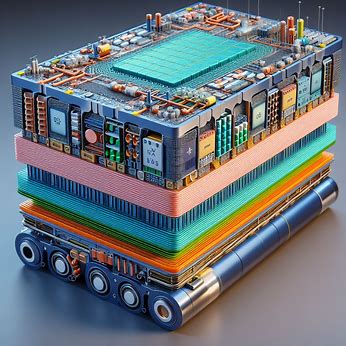Next- Generation Batteries Powering
Coming- generation batteries represent a vital advancement in energy storehouse technology, offering increased energy viscosity, briskly charging rates, longer cycle life, and bettered safety compared to conventional battery systems. As the demand for energy storehouse results continues to rise in sectors similar as electric vehicles, renewable energy integration, and movable electronics, the development of coming- generation batteries holds significant pledge for addressing crucial challenges and driving invention in these diligence. In this composition, we explore the rearmost advancements, operations, challenges, and unborn prospects of coming- generation batteries.
Understanding Next- Generation Batteries
Coming- generation batteries encompass a different range of battery technologies that surpass the performance and capabilities of traditional lithium- ion batteries. These technologies include solid- state batteries, lithium- sulfur batteries, sodium- ion batteries, inflow batteries, and beyond. While each technology has its unique characteristics and advantages, they all partake the common thing of delivering advanced energy viscosity, bettered safety, and enhanced sustainability.
1. Solid- State Batteries
Solid- state batteries use solid electrolytes rather of liquid electrolytes set up in conventional lithium- ion batteries. Solid electrolytes offer several advantages, including advanced energy viscosity, bettered safety, and wider operating temperature range. Solid- state batteries are also less prone to dendrite conformation, a common cause of battery failure and safety hazards in lithium- ion batteries. By replacing liquid electrolytes with solid- state druthers , solid- state batteries offer the eventuality for advanced energy viscosity and longer cycle life, making them ideal for electric vehicles, consumer electronics, and grid storehouse operations.
2. Lithium- Sulfur Batteries
Lithium- sulfur batteries use sulfur as the cathode material and lithium essence or lithium- ion as the anode material. Lithium- sulfur batteries offer significantly advanced theoretical energy viscosity compared to lithium- ion batteries due to the featherlight and high energy content of sulfur. still, lithium- sulfur batteries face challenges similar as polysulfide dissolution, low conductivity of sulfur, and volume expansion during charge and discharge cycles, leading to poor cycle life and limited practicality. Despite these challenges, ongoing exploration and development sweats aim to overcome these limitations and unleash the full eventuality of lithium- sulfur batteries for electric vehicles, aerospace, and grid- scale energy storehouse.
3. Sodium- Ion Batteries
Sodium- ion batteries are an volition to lithium- ion batteries that use sodium ions rather of lithium ions for energy storehouse. Sodium- ion batteries offer several advantages, including abundant and low- cost raw accoutrements , bettered safety, and reduced environmental impact compared to lithium- ion batteries. Sodium- ion batteries are particularly well- suited for stationary energy storehouse operations, similar as renewable energy integration, grid stabilization, and provisory power systems. still, challenges similar as lower energy viscosity, advanced operating voltage, and limited cycle life compared to lithium- ion batteries need to be addressed to enable wide relinquishment of sodium- ion batteries.
4. Flow Batteries
Flow batteries are a type of rechargeable battery that stores energy in chemical results contained in external tanks. Flow batteries offer scalability, inflexibility, and long cycle life, making them ideal for grid- scale energy storehouse operations. Flow batteries use redox responses between electrolyte results to store and release energy, enabling rapid-fire response times and high effectiveness. Flow battery technologies, similar as vanadium redox inflow batteries( VRFBs), zinc- bromine inflow batteries, and organic inflow batteries, are being laboriously delved and developed for operations ranging from renewable energy integration to microgrid stabilization and electric vehicle charging structure.
Operations of Next- Generation Batteries
Coming- generation batteries have different operations across colorful sectors, including transportation, renewable energy, electronics, and grid storehouse. Some of the crucial operations of coming- generation batteries include
1. Electric Vehicles ( EVs)
Coming- generation batteries play a pivotal part in the wide relinquishment of electric vehicles by offering advanced energy viscosity, briskly charging rates, and longer driving range compared to conventional lithium- ion batteries. Solid- state batteries, lithium- sulfur batteries, and sodium- ion batteries are being explored as implicit campaigners for coming- generation EV batteries, offering bettered performance, safety, and sustainability.
2. Renewable Energy Integration
Coming- generation batteries enable the effective storehouse and application of renewable energy sources, similar as solar and wind power, by furnishing grid- scale energy storehouse results. Flow batteries, in particular, are well- suited for storing intermittent renewable energy and balancing force and demand on the grid. By integrating coming- generation batteries with renewable energy systems, communities, businesses, and serviceability can reduce reliance on fossil energies and transition to a more sustainable and flexible energy structure.
3. movable Electronics
Next- generation batteries offer enhanced performance and continuity for movable electronics, similar as smartphones, laptops, and wearable bias. Solid- state batteries and lithium- sulfur batteries hold the eventuality to extend battery life, reduce charging times, and ameliorate overall device performance. These advancements enable manufacturers to produce lower, lighter, and further energy-effective electronic bias, enhancing stoner experience and convenience.
4. Grid- Scale Energy Storage
Next- generation batteries are decreasingly stationed for grid- scale energy storehouse operations to ameliorate grid stability, trustability, and adaptability. Flow batteries, in particular, are well- suited for storing redundant energy during ages of low demand and releasing it during peak demand ages. Grid- scale energy storehouse results help serviceability manage grid traffic, optimize renewable energy integration, and enhance overall grid inflexibility and effectiveness.
Challenges and Considerations
Despite their immense eventuality, coming- generation batteries face several challenges and considerations that need to be addressed to enable wide relinquishment and commercialization. Some of the crucial challenges include
1. Cost
Cost remains a significant hedge to the wide relinquishment of coming- generation batteries, particularly for arising technologies similar as solid- state batteries and lithium- sulfur batteries. High accoutrements costs, manufacturing complications, and scale- up challenges contribute to the overall cost of coming- generation batteries, limiting their competitiveness with conventional lithium- ion batteries.
2. Scalability
Scalability is another challenge for coming- generation battery technologies, particularly for grid- scale energy storehouse operations. Achieving large- scale product and deployment of coming- generation batteries requires prostrating manufacturing constraints, force chain limitations, and structure conditions. spanning up product capacity while maintaining quality, thickness, and cost- effectiveness is essential for marketable viability and request penetration.
3. Safety
Safety considerations are consummate for coming- generation batteries, particularly for technologies similar as lithium- sulfur batteries and solid- state batteries, which may parade unique safety pitfalls and failure modes. Addressing safety enterprises related to thermal raw, dendrite conformation, and electrolyte insecurity is critical for icing the trustability, continuity, and consumer acceptance of coming- generation batteries.
4. Environmental Impact
Environmental sustainability is a crucial consideration for coming- generation batteries, as the birth, processing, and disposal of raw accoutrements can have significant environmental impacts. Addressing issues similar as resource reduction, pollution, and recycling of battery accoutrements is essential for minimizing the environmental footmark of coming- generation batteries and promoting a indirect frugality.
Recent Advancements and unborn Prospects
Recent times have witnessed significant advancements in coming- generation battery technologies, driven by exploration and development sweats worldwide. Some of the recent advancements include
1. Solid- State Batteries Experimenters have made significant progress in developing solid- state batteries with bettered performance, stability, and safety. Advances in solid electrolyte accoutrements , affiliate engineering, and manufacturing ways have led to commercially feasible solid- state battery prototypes with advanced energy viscosity and longer cycle life.
2. Lithium- Sulfur Batteries Research sweats concentrated on prostrating the challenges of lithium- sulfur batteries have redounded in bettered electrode accoutrements , electrolyte phrasings, and cell designs. new approaches, similar as sulfur encapsulation, conductive complements, and electrolyte variations, have demonstrated significant advancements in energy
3 Sodium-ion batteries: Sodium-ion batteries have proven to be a promising alternative to lithium-ion batteries, offering advantages such as an abundance of raw materials, lower costs and a lower environmental impact. Research efforts are focused on developing high-performance electrode materials, electrolyte formulations and cell architectures to address the challenges faced by sodium-ion batteries and enable commercialization of grid-scale energy storage applications.
Flow Batteries: Advances in flow battery technology have led to improvements in energy density, efficiency and cost-effectiveness in grid-scale energy storage applications. Research efforts focus on developing new electrolyte chemistries, membrane materials and flow cell designs to increase the performance and scalability of flow battery systems. Integrating flow batteries into renewable energy sources and microgrid applications can help address issues such as grid stability, intermittency and peak load management.Application: Next-generation
batteries hold promise for addressing key challenges in energy storage, transportation and grid stability, ushering in a new era of innovation and sustainability. By leveraging advances in materials science, engineering and manufacturing, next-generation batteries offer higher energy density, faster charging and greater safety than traditional lithium-ion batteries.
While challenges such as cost, scalability, safety and environmental impact still need to be resolved, ongoing research and development efforts are paving the way for the commercialization and widespread adoption of next-generation batteries. As we continue to push the boundaries of energy storage technology, next-generation batteries will play a key role in the transition to a more sustainable and resilient energy future.
RELATED POST....
radiation Protection technology
transportation technology on mars
Impact of Technology on Ancient Industries
the Environmental impact of E west
augmente reality in feild passage
nassa mission to touch the sun
important Rocket Set to Soar into the Cosmos
20 Instances of Digital Technology
wolrd fastest wooden satellite in 2024
Electric vehicles charging in 2024
Ultraloq Bolt and the Smart Lock
Unraveling the Apple Patent Dispute:
CineBeam Qube 4K UHD Projector
Twitter-X Elon Musk Content Moderation
tesla Cybertruck crash in palo alto




.jpeg)



.jpeg)






.png)
0 Comments